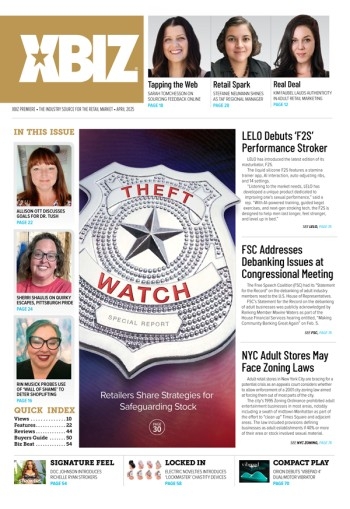As consumers’ curiosity about BDSM continues to grow, driving them to explore this kink more and more deeply, we are seeing demand for gear specific to particular activities. The market for rope play has been expanding — particularly due to interest in shibari.
Shibari has a rich history and tradition that is important to recognize and acknowledge, so that’s what I’m going to focus on today.
Getting familiar with the safety details can help you be an even better resource for your customers.
Let’s talk about where shibari comes from, why people like it, what you need in order to do it and how to do it safely. We’ll also discuss ways retailers can support shoppers as they prepare to explore. Because there is more to shibari than simply tying people up!
What is shibari?
Shibari originated in Japan, and is also referred to as Japanese bondage or Kinbaku. It typically involves one partner — the “rigger” or “rope top” — using rope to restrain, suspend, wrap or restrict the movement of the other partner — the “rope bottom.” The term “shibari” roughly translates to “to bind” or “to tie,” and the practice often involves elaborate and intricate knots that both restrain and deliver sensation.
In Western culture, “shibari” is often used interchangeably with terms like “rope play” and “rope bondage,” but there is a difference. When it comes to BDSM, shibari is arguably the most popular style of rope bondage, but it is not the only style. Alternatives like Western bondage are more focused on restraining the rope bottom, while in shibari there is deep focus on the artistry of the tying process.
Why do people like rope play?
When it comes to “why,” there are probably nearly as many explanations as there are rope play enthusiasts. People who enjoy being tied up cite a wide array of reasons, including relaxation, excitement, helplessness, expectation, release, presence, thrill-seeking and more. For people who enjoy doing the tying, there is an equally broad range of explanations, including enjoying the sense of power, reveling in the artistry, being turned on by the appearance of a bound body or enjoying watching their partner experience pleasure from being bound.
History of shibari
So, where did shibari come from? Law enforcement. Yes, really. In Japan from 1400 to 1700, local police and Samurai confined prisoners using Hojojutsu, the martial art of restraining captives. This involved a variety of tying techniques designed to indicate the status of each prisoner. Eventually, as we humans are wont to do, people found a way to eroticize this practice and created the art of erotic bondage.
Midori, the author of “Seductive Art of Japanese Bondage,” told wellness website mindbodygreen.com: “In the same way that kinky people of European heritage have incorporated legends and tools of medieval European incarceration, such as Saint Andrew’s Cross and shackles, into their sexual shadow play, so have Japanese folks found carnal inspiration from historical fables of their captured maidens and incarcerated heroes.”
Terms to know
Here are some basic terms that sales staff should be familiar with, as they are helpful to know when talking about rope play:
- Rigger or rope top: The partner who does the tying.
- Rope bottom: The partner who gets tied up.
- Suspension: Just like it sounds, this involves using rope to suspend the bottom above the floor. This is considered an advanced form of shibari.
- Floor tie: This is any rope play that is done on the floor, as opposed to being tied to a surface or suspended.
- Safe word/safe signal: An agreed-upon word, phrase or signal that, when spoken or given, brings the rope play to a halt.
Types of rope
There are several different types of rope used for rope play, so it makes sense to stock many options. Among the variety:
- Jute is a natural rope that is light and springy, but takes some time to break in. It is not recommended for suspension, as it can weaken over time.
- Cotton rope is another natural fiber option. It can vary in strength depending on the manufacturer and can be difficult to untie. It is not recommended for use in suspension. That said, it is also very soft and ties easily.
- Hemp is the strongest of the natural fibers on this list. It is soft and it knots easily. Riggers often recommend hemp for suspension.
- Nylon is a popular choice because it is durable and machine washable. Due to its slippery nature, nylon is not recommended for beginners.
When it comes to rope lengths, shibari traditionally uses ropes that are cut into approximately 25-foot lengths, while Western bondage employs longer ropes.
Safety notes
Getting familiar with the safety details can help you be an even better resource for your customers. Here are some key points that everyone should know before embarking on a shibari adventure:
- Communication is key. Folks who engage in rope play need to be able to talk with honesty and transparency about limits, experience, abilities, aftercare needs, safety cues, etc.
- No rope play with partners you don’t fully trust.
- Sober play is safe play.
- Make a game plan before you play. What does everyone want? How should it work? What are the boundaries? Talk it out first.
- Safety shears are a must. Make sure you keep these in stock too!
I also recommend having at least one book for sale that outlines not just the safety and how-to’s of shibari, but also some context. That way, shoppers have a resource they can take home along with their rope and gear. Plus, it’s an add-on sale! Midori’s “Seductive Art of Japanese Bondage” is a great place to start.
Safe and educated customers are return customers!
Odds are you already have shoppers who are curious about shibari, if they aren’t already full-on rope-play enthusiasts. With a little knowledge and forethought, you can keep your shelves stocked and your staff ready to give those shoppers everything they need to explore safely and with intention. That way, they’ll be more likely to have a satisfying experience — and to come back the next time they need to stock up on rope or other sexy supplies.
Rebecca Weinberg is an award-winning industry leader with more than 20 years of experience in the adult industry. She is the president of multi-award-winning pleasure product manufacturer XR Brands.








